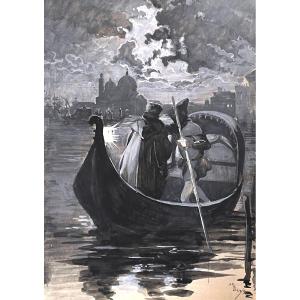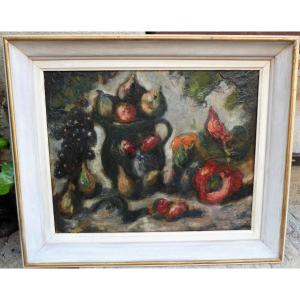Lefteris Kanakakis was born in Rethymno in 1934. In 1954, he entered the Athens School of Fine Arts on a scholarship. His professors were Spyros Papaloukas and Yiannis Moralis. He stayed in Paris for the first time with a scholarship from the Mika Skouze Foundation (1960–1961). Later, supported by a grant from the National Scholarship Foundation, he enrolled at the École des Beaux-Arts in Paris, in the studio of Maurice Brianchon (1963–1966). In 1968, he became an assistant in the preparatory class at the Athens School of Fine Arts, a position he left in 1978. He was a member of the Chamber of Fine Arts and a founding member of the Centre of Fine Arts.
Until the late 1970s, his painting focused mainly on still lifes and interiors. Some of his compositions—especially during the military dictatorship in Greece—conveyed a direct political critique of the circumstances. A major turning point in his work appeared around 1980, when he devoted himself almost exclusively to female nudes and portraits.
He held his first solo exhibition at the Municipal Gallery of Rethymno in 1960. After returning from Paris, he exhibited at the Astor Gallery in Athens in 1969. In 1974, his works were shown at the Zoumboulaki Gallery in Athens and at the "Kochlia" gallery in Thessaloniki. In 1977, the "Ora" gallery presented his work in Athens and at the Rethymno Festival of Fine Arts. In 1978, his work was exhibited in Heraklion (Stavrakaki Gallery); in 1980 at the “Nees Morfes” gallery in Athens; and in 1982 at the Heraklion Art Gallery. In 1983, a retrospective of his work was organized at the Basilica of Saint Mark in Heraklion. His final solo exhibition took place at the “Nees Morfes” gallery in Athens in 1984.
His main participations in group exhibitions include:
1969 – Sixth Paris Biennale
1971 – Greek Art Today, Upper Grosvenor Galleries, London
1976 – Panorama of Greek Painting 1950–1975, National Gallery of Athens
1976 – Panorama of the Last 25 Years of Greek Painting, Am Ostwall Museum, Dortmund
1985 – Contemporary Currents of Modern Greek Art, National Gallery of Athens
1985 – Memories, Reconstructions, Research, National Gallery
1986 – Exhibition of Professors of the Athens School of Fine Arts at Apopsi, co-organized in the EAT/ESA building, “Pictorial Space – Theatricality”, in Palaio Faliro
In November 1983, he received the Kazantzakis Prize from the Municipality of Heraklion. He authored The Technique of Oil Painting, a manual for students of the Athens School of Fine Arts — a unique study in Greek art literature. He passed away on January 2, 1985, at a particularly creative moment in his life. A year after his death (1986), the National Gallery of Athens organized a large retrospective of his work. In 1989, a Municipal Gallery was founded in Rethymno and named after him. It holds a large collection of his works. The Municipal Gallery “L. Kanakakis” – Museum of Contemporary Art of Crete – was inaugurated and opened to the public in 1992 under the mayorship of Dimitris Archontakis.
His drawing aimed to capture the most subtle variations of light on curved surfaces, to transform the unreal space of the white paper into the natural atmosphere of the depicted object, to interpret the critical encounter between space and form — what some art historians have identified as the core of Cézanne’s painting. Even to a trained eye, this persistence may have seemed paradoxical — until one day, everything made sense.
Kanakakis’s first exhibitions revealed a mature painter, confident in his technique, master of his expressive means, and, above all, endowed with a personal artistic vision.
“Lefteris Kanakakis, several years after completing the Athens School of Fine Arts — and even more significantly, after his postgraduate studies in Paris — was still drawing spherical forms with the stubbornness of a Cézanne: fruits, eggs, etc.”
Kanakakis’s painting was always figurative. No one familiar with his work could believe he merely followed the trend of the return to figuration that swept Europe and America at the same time. He did not share a dominant characteristic of European realism or American surrealism: their dependence on mechanical means of image reproduction.
The artist remained faithful to vision — the sense Plato deemed noblest, and that Leonardo da Vinci glorified. He also remained faithful to traditional techniques. His medium of choice was oil painting — as evidenced by his work and his in-depth essay on the subject.
Kanakakis’s early works are almost exclusively still lifes — a rough equivalent of the term used by Latin-based languages to describe paintings of inanimate objects. The term natura morta was introduced in 18th-century Italy with a pejorative nuance, in contrast to the “noble” natura vivente of the academic tradition. The English still life and German Stilleben, older and more authentic, would better suit Kanakakis’s work. In 17th-century Dutch painting, the term referred to a “resting motif,” in contrast to the moving live model.
A silent world, populated with rare, carefully chosen objects: this is what Kanakakis’s still lifes propose. A simple rectangular table with a single object. A Viennese chair with curved lines. Simple, geometric forms. Form, color, texture: these are the means of access to this enclosed universe.
The composition is simple, sometimes archaically frontal, recalling 17th-century Spanish bodegones (Zurbarán, Velázquez). Space is defined by the objects themselves. The canvas surface is inviolable. No optical illusions. Everything is tangible. The tactile properties are emphasized through fine modeling of tones that avoid extremes (black and white). The solitude of the objects, their arrangement, their angle, grant them solidity, power, and soul.
Kanakakis chose objects steeped in history — their own and their bond of love with the painter. Simple earthen vessels, warm from the hands that shaped them. Aged objects, worn by time, sanctified by use. “These are objects,” the painter once told me, “that I kept seeing; that were in my home; that I had seen here or there; I had observed how the light fell on them, what it produced.” Simple objects — pot, jug — that sometimes become monumental.
Over time, the inhabitants of this world multiply. The painter orchestrates a more complex, more mature visual conversation. Geometric shapes, the table, an oval mirror engage in dialogue with a striped silk fabric, seemingly tossed casually on a chair. But the painter deceives no one: everything is calculated. Motifs, rhythm, textures — from shiny to plush.
Bright, iridescent colors are in magnetic attraction, in constant migration. They pass imperceptibly from one plane to another. An alchemy, a secret osmosis takes place, with light as a catalyst. A light woven into the color, regulating space, reconciling its objects. A sensitive, tonal, lyrical light that favors pure, Platonic forms — carriers of eternity.
During the years of the Greek dictatorship, the choice of objects in his still lifes was not dictated solely by aesthetics. Trumpets, helmets, profaned symbols of patriotism, then flags of revolt, funeral ribbons, empty jackets, sinister hats: all became part of a narrative of anguish. Proof that the shell of another time is not inviolable. These “vile signs” found their way into the still life.
Yet the “hermit” painter does not surrender, does not throw himself into the fray. He transmutes, evokes, comments with subtlety. His artistic language remains the same — perhaps sharper, filled with anger and bitterness.
— Marina Lambraki-Plaka
Professor of History of Art, Athens School of Fine Arts
Director, National Gallery – Alexandros Soutsos Museum
Bibliography:
L. Kanakakis, The Art of Oil Painting (in Greek), Athens, 1981 (published by the Athens School of Fine Arts, not for sale). Republished in 2002 by the C.C.A. Available at the C.C.A.


































 Le Magazine de PROANTIC
Le Magazine de PROANTIC TRÉSORS Magazine
TRÉSORS Magazine Rivista Artiquariato
Rivista Artiquariato